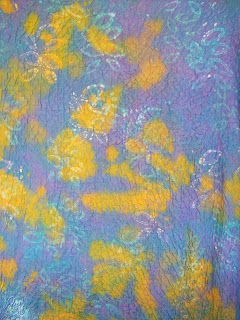I would love to say more, but its almost Christmas and we have other things on our minds. Below are several images from the shows. An overview of the No Rules exhibition may be viewed on No Rules: Rediscovering Embroidery courtesy of Matt Blomeley at Objectspace.
If you do have some spare time over the holidays here is a link to another blog you might like to visit www.dailyvisuals.blogspot.com. It is written by Jane Dunnewold (of the book Complex Cloth fame). She has committed herself to a year of daily entries, photographing the world around us and making artistic observations. She started on 11 November. It will make you look at things in a more thoughtful way.
My next blog will be on Friday, 2 January 2009. Until then all the very best to everyone for a great holiday season; and thank you for continuing to read my blog.

My piece in the No Rules exhibition, Object Space. Where Did This Come From challenges the inappropriate image of the girl in New Zealand.

View of the Post Stitch exhibition

My piece(s) are in the middle of this group; two pieces connected by a thread. Titled Connecting it references the connections made when communicating.

Side gallery at Lopdall House with larger pieces

Another view of Post Stitch pieces. Katherine Morrison's Sub Rosa - Under the Rose in the foreground.

Post Stitch again. Clare Plug's ASPA 156 - Erebus Voices
Next Blog: 2009 here we are!







.JPG)


.JPG)







































